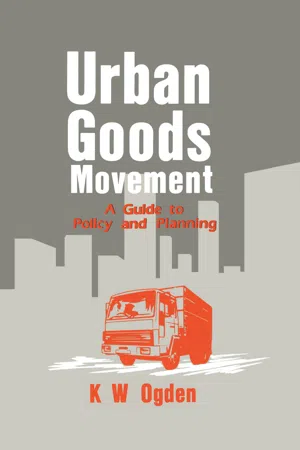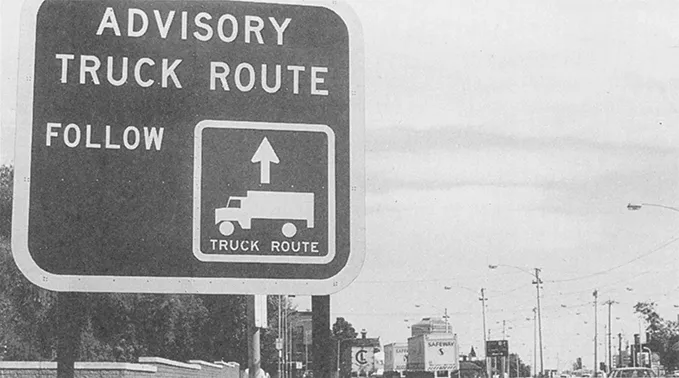
- 416 pages
- English
- ePUB (mobile friendly)
- Available on iOS & Android
About This Book
Freight transport is essential to modern urban civilization. No urban area could exist without a reliable freight transport system. Although the private sector is responsible for much of this system, the public sector has a vital role to play in the provision of infrastructure and the establishment of a social and legal framework within which transport can occur. For these reasons, goods movement deserves and is increasingly receiving, explicit consideration in urban transport policy and planning. Many cities around the world have conducted studies aimed at resolving urban goods movement problems and a considerable, if disparate, body of research results are available. This book brings together much of this knowledge and experience in a comprehensive source of information on urban freight, particularly from a public policy or planning viewpoint. It provides both a conceptual basis for urban goods movement analysis and detailed, practical guidelines which may be used directly by those responsible for urban freight policy and planning. The author has worked for over twenty years in this field and he draws upon his experience in Australia, the United States, Great Britain, Canada and The Philippines to produce a book which is international in scope and perspective. The book is written for practising professionals, such as engineers, economists and planners, working in local government, urban transport planning agencies, highway authorities, consultancies, or research institutes; it is also relevant to graduate courses in transport planning, traffic engineering or urban policy. It is of interest to all who have a concern for contemporary issues in urban development.
Frequently asked questions
Part B
Planning: Strategies for Improvement
6 Traffic management
Introduction
- – measures at a network level;
- – measures at a site level;
- – measures directed at parking and loading; and
- – the removal of physical impediments to truck movement.
Network strategies
Truck routes
- – agreement must be reached between the various local governments in the urban area encompassing the network;
- – the network should serve the major generators of truck traffic in as convenient and direct a manner as possible;
- – it should comprise most if not all freeways and main arterial roads, with connecting and access links as necessary;
- – the roads themselves should be in good condition, having adequate structural strength and geometric layout to accommodate larger, heavier vehicles, and should be reasonably smooth to minimize vibration;
- – structures on the network should have adequate strength, and overhead clearances should be at least equal to the legal height limit for trucks in that state or nation;
- – traffic lanes should be of adequate width, which may vary with the maximum permitted width of trucks in that state or nation; generally a lane width of around 3.6 m (12 ft) is appropriate;
- – steep grades should be avoided, especially in localities where noise is a problem; perhaps a 4 percent grade would be a desirable maximum;
- – the network should be selected with consideration for abutting land uses; residential and retail land uses and areas with high pedestrian activity should be avoided as much as possible;
- – consideration should be given to present traffic volumes on the roads, and the capacities of intersections to accommodate extra truck traffic;
- – roads used as part of the network must be through roads, with reasonable connection to other roads comprising the network, and with as few sharp turns as possible; this may mean that some reconstruction of intersections is necessary, e.g. to provide turn lanes;
- – similarly, traffic control on all roads on the network should be adequate, with STOP or GIVE WAY control on all minor side streets, and signals or grade separations at all major intersections; roundabouts with small central islands should be avoided;
- – driver and vehicle facilities should be provided along the route, and provision made for easy access to them and easy re-entry back on to the through route; these facilities include fuel, parking, toilets, telephones, food, etc;
- – the network should be developed in close cooperation with the road freight industry, unions, and other affected parties such as public transport operators;
- – in implementation, careful attention must be given to signing (Figure 6.1), and the distribution of maps and other publicity advising of the network and its conditions;
- – further to the previous two points, the definition of vehicle to be affected by the route needs careful attention (e.g. mass, length, number of axles); this determines both the effectiveness of the network and its impacts on operators, and also the extent of enforcement in the case of a statutory truck route; and
- – in the case of a statutory network, route designation must comply with relevant legislation.

Routes for designated vehicles
Table of contents
- Cover Page
- Half title
- Title Page
- Copy Right Page
- Content page
- List of tables
- List of figures
- Foreword
- Preface
- Part A Policy
- Part B Planning: Strategies for Improvement
- Part C Implementation: From Ideas to Action
- References
- Index